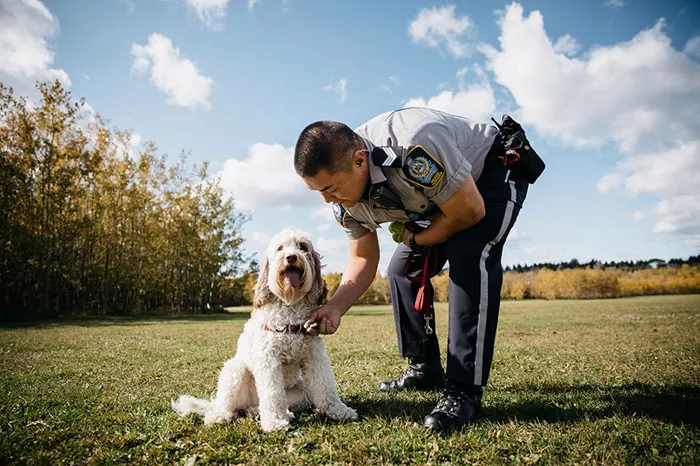Edmonton pet owners should watch their pets closely. The city is preparing a major revision of its Animal Licensing and Control Bylaw. This update will bring stricter rules and higher fines.
On Monday, city officials presented a plan to replace Bylaw 13145, which has been in effect for over 20 years. If approved, the new rules will change how Edmonton handles animal welfare, public safety, and responsible pet ownership.
Why Change the Bylaw?
City officials say the current bylaw no longer matches modern standards or the expectations of residents. The new proposal aims to close enforcement gaps, improve safety, promote responsible pet ownership, and update rules to fit today’s urban life.
The new bylaw focuses on four main areas:
- Improving animal welfare
- Responding to dog attacks and bites
- Updating rules for restricted dogs
- Clarifying the differences between owned, unowned, and feral cats
One key change is stronger enforcement for animal welfare. Since 2020, over 10,000 calls about animal welfare issues were reported. More than 5,000 animals have been seized due to neglect. The new bylaw will allow quicker action when pets are abandoned, transported unsafely, or left in dangerous situations like hot cars.
Liza Sunley, CEO of the Edmonton Humane Society, expressed strong support for these changes. She told city councillors that the organization sees many abandoned animals every month. Current laws do not give enough tools to hold owners accountable. Strengthening enforcement will help prevent animal suffering, she said.
Stricter Fines for Dog Attacks
The city is proposing a tiered fine system due to a record 1,018 dog attack investigations in 2023. Under the current bylaw, most dog bite incidents get a flat $100 fine. Officials say this does not match the severity of some attacks.
The new rules would set four levels of fines based on the injury’s seriousness:
- $250 for chasing a person or animal (up from $100)
- $500 for a first-time bite or attack
- $1,000 for a second bite or attack
- Even higher fines for attacks causing serious injury or death
The bylaw would also require mandatory reporting of dog bites to improve enforcement.
Expanded Rules for Restricted Dogs
Currently, a dog becomes restricted only after a conviction. This status lasts for life, with no appeal. The designation is based on behavior, not breed, since breed-specific bans were removed in 2012. Restricted dogs require liability insurance, strict control, and face higher fines for serious offenses.
The updated bylaw would add new requirements, including mandatory microchipping, behavior training, and a chance to review the restricted status after three years of good behavior and proper licensing. Officials say this approach balances public safety with responsible ownership.
New Rules for Feral Cats
Feral cats are wild and avoid humans. They survive without direct care. Unowned cats, by contrast, may accept human contact and are often fed by caregivers who don’t claim ownership.
Until now, Edmonton treated all cats the same under the law. This sometimes forced caregivers of feral cats to take on licensing responsibilities. The new bylaw clarifies these differences, which is important since there are an estimated 70,000 feral cats in the city.
The bylaw supports humane programs like trap-neuter-return (TNR) and return-to-field (RTF). These involve capturing, sterilizing, vaccinating, and returning cats to their original locations. Experts say these methods help control feral cat populations responsibly.
Colleen Cassady St. Clair, a University of Alberta biology professor, supports this approach. She said it encourages caregivers to manage feral cats without risking euthanasia in shelters. She also warned that ignoring feral cat populations could harm local wildlife and public health. Cats kill birds, small mammals, amphibians, and reptiles. They can spread parasites like toxoplasma gondii, which affects about one-third of people worldwide.
However, not all experts agree. Amy Wilson, a veterinarian and professor at the University of British Columbia, criticized the proposed changes. She said free-roaming cats spread diseases and parasites through their feces. Children are especially at risk. Wilson questioned the effectiveness of TNR programs, noting that sterilizing 75-90% of a population is needed to reduce numbers — a difficult goal. She argued that TNR may cause ongoing suffering due to inefficiency.
The proposal keeps existing rules that require owned cats to stay off other people’s property unless allowed. This matches public opinion: 63% of surveyed residents agree with these restrictions, and 79% of cat owners already keep their pets indoors.
Next Steps
The city committee will review the proposed changes on August 11. If approved, the full bylaw will go to city council on August 19 for final approval. If passed, the new bylaw will take effect in May 2026. Before then, the city will launch a campaign to inform residents and encourage responsible pet care.

